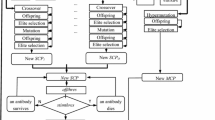Abstract
Nowadays, the importance of timely delivery, which is based on the just in time concept, has caused a number of criteria related to scheduling problems to be taken into consideration. One of the most important of these criteria is maximum earliness to control final costs and number of tardy jobs in an attempt to win customer satisfaction. In this paper, the strongly NP-hard problem of the single machine scheduling with two criteria, i.e., maximum earliness and number of tardy jobs, has been considered. For this purpose, artificial immune system which is inspired by the immunology theory in biology has been used. This algorithm is applied to different instances of small to large sizes and the obtained results is compared with those obtained from a heuristic method and a genetic algorithm reported in the literature. Computational results show a significant preference for the algorithm proposed in this paper.
Similar content being viewed by others
References
KR Baker (1974) Introduction to sequencing and scheduling. Wiley, Chichester
Hoogeveen H (2005) Multicriteria scheduling. Eur J Oper Res 167:592–623
Wan G, Yen BPC (2009) Single machine scheduling to minimize total weighted earliness subject to minimal number of tardy jobs. Eur J Oper Res 195:89–97
Güner E, Erol S, Tani K (1998) One machine scheduling to minimize the maximum earliness with minimum number of tardy jobs. Int J Prod Econ 55:213–219
Köksalan M (1999) A Heuristic approach to bicriteria scheduling. Nav Res Logist 46:777–789
Azizoglu M, Kondakci S, Köksalan M (2003) Single machine scheduling with maximum earliness and number tardy. Comput Ind Eng 45:257–268
Jolai F, Rabbani M, Amalnick S, Dabaghi A, Dehghan M, Yazdan Parast M (2007) Genetic algorithm for bi-criteria single machine scheduling problem of minimizing maximum earliness and number of tardy jobs. Appl Math Comput 194:552–560
Moore JM (1968) An n job one machine sequencing algorithm for minimizing the number of late jobs. Manage Sci 15:102–109
Engin O, Döyen A (2004) A new approach to solve hybrid flow shop scheduling problems by artificial immune system. Future Gener Comput Syst 20:1083–1095
Chandrasekaran M, Asokan P, Kumanan S, Balamurugan T, Nickolas S (2006) Solving job shop scheduling problems using artificial immune system. Int J Adv Manuf Technol 31:580–593
Tavakoli-Moghadam R, Rahimi-Vahed A, Hosein Mirzaei A (2007) A hybrid multi-objective immune algorithm for a flow shop scheduling problem with bi-objectives weighted mean completion time and weighted mean tardiness. Inf Sci 177:5072–5090
Hong L (2009) A novel artificial immune algorithm for job shop scheduling. Proceeding of 2009 International Conference on Computational Intelligence and Natural Computing. CINC 1:38–41. doi:10.1109/CINC.2009.238
Naderi B, Khalili M, Tavakkoli-Moghaddam R (2009) A hybrid artificial immune algorithm for a realistic variant of job shops to minimize the total completion time. Comput Ind Eng 56:1494–1501
Bagheri A, Zandieh M, Mahdavi I, Yazdani M (2010) An artificial immune algorithm for the flexible job–shop scheduling problem. Future Gener Comput Syst 26:533–541
Gao J (2010) A novel artificial immune system for solving multiobjective scheduling problems subject to special process constraint. Comput Ind Eng 58:602–609
Lee CY, Vairaktarakis GL (1993) Complexity of single machine hierarchical scheduling: a survey. Complex Numer Optim 19:269–298
De Castero LN, Von Zuben FJ (2002) Learning and optimization using the clonal selection principle. IEEE Trans Evol Comput 6:239–251
Engelbrecht AP (2007) Computational intelligence: an introduction, 2nd edn. Wiley, Chichester
Agarwal R, Tiwari MK, Mukherjee SK (2007) Artificial immune system based approach for solving resource constrained project scheduling problem. Int J Adv Manuf Technol 34:584–593
Author information
Authors and Affiliations
Corresponding author
Rights and permissions
About this article
Cite this article
Reisi, M., Moslehi, G. Minimizing the number of tardy jobs and maximum earliness in the single machine scheduling using an artificial immune system. Int J Adv Manuf Technol 54, 749–756 (2011). https://doi.org/10.1007/s00170-010-2978-7
Received:
Accepted:
Published:
Issue Date:
DOI: https://doi.org/10.1007/s00170-010-2978-7




